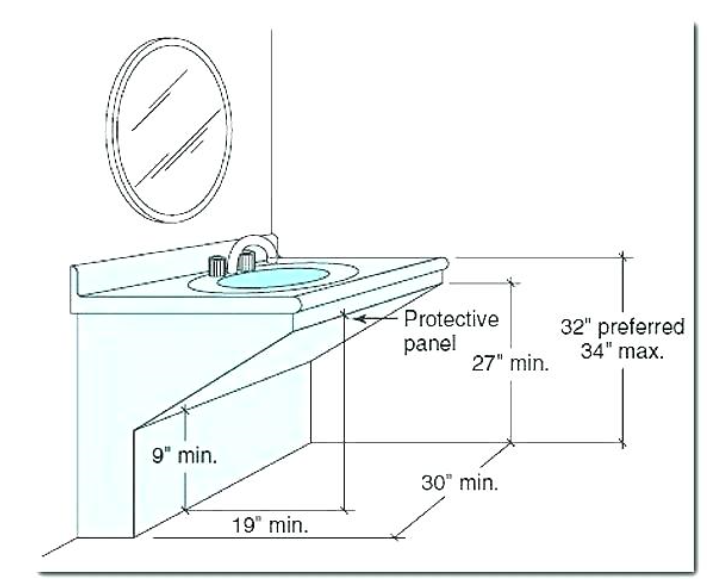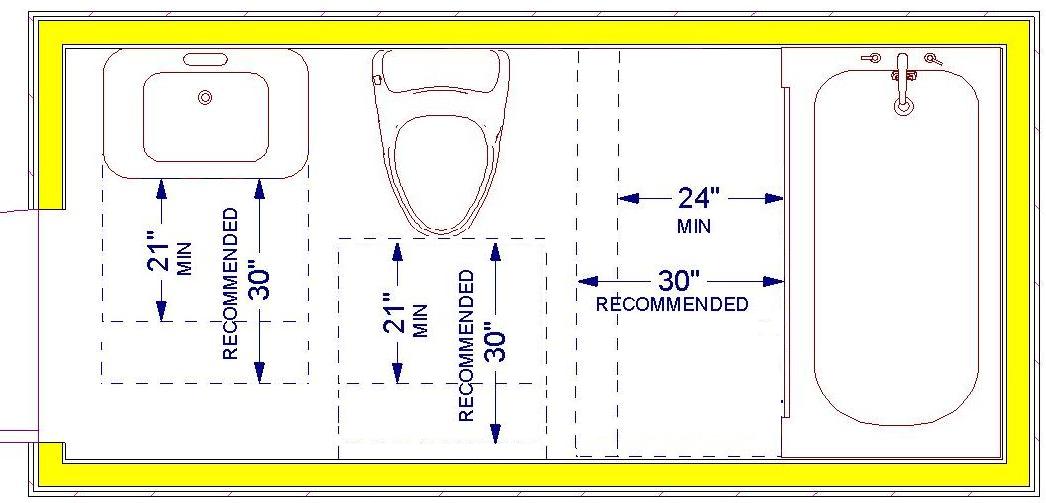Navigating the Space: Understanding the Importance of Adequate Vanity Clearance
Related Articles: Navigating the Space: Understanding the Importance of Adequate Vanity Clearance
Introduction
With great pleasure, we will explore the intriguing topic related to Navigating the Space: Understanding the Importance of Adequate Vanity Clearance. Let’s weave interesting information and offer fresh perspectives to the readers.
Table of Content
Navigating the Space: Understanding the Importance of Adequate Vanity Clearance

The bathroom is a space of personal sanctuary, a place for rejuvenation and daily rituals. It’s also a space that demands careful planning, particularly when it comes to the placement of key elements like the vanity. While aesthetics play a significant role in bathroom design, functionality is paramount, and this is where the concept of "minimum clearance" in front of the vanity takes center stage.
Understanding the Concept of Minimum Clearance
Minimum clearance, in the context of bathroom design, refers to the minimum amount of open space required in front of the vanity to allow for comfortable and safe movement. This space is not just a matter of aesthetics but a crucial factor for functionality and accessibility. Insufficient clearance can lead to a cramped and frustrating experience, hindering daily routines and potentially posing safety risks.
The Importance of Adequate Clearance
-
Enhanced Functionality: Adequate clearance ensures ease of movement around the vanity, facilitating activities like washing hands, brushing teeth, applying makeup, or shaving. This space allows for comfortable access to the sink, drawers, and storage compartments, making daily routines more efficient and pleasant.
-
Safety and Accessibility: A well-designed bathroom prioritizes safety, and adequate clearance plays a crucial role in achieving this. Ample space prevents collisions with the vanity or other bathroom fixtures, reducing the risk of injuries, especially for individuals with mobility challenges.
-
Improved Aesthetics: While functionality is paramount, adequate clearance also contributes to a more balanced and aesthetically pleasing bathroom design. A spacious feel around the vanity enhances the overall sense of openness and creates a more inviting atmosphere.
Determining the Ideal Clearance
The ideal minimum clearance in front of the vanity varies depending on several factors, including:
-
Vanity Size: Larger vanities naturally require more clearance to allow for comfortable access.
-
Bathroom Size: The overall size of the bathroom dictates the available space and influences the recommended clearance.
-
Individual Needs: Personal preferences and physical limitations, such as mobility issues or height, should be considered when determining the appropriate clearance.
-
Layout and Design: The placement of other bathroom fixtures, such as the toilet, shower, or bathtub, can affect the optimal clearance in front of the vanity.
General Guidelines for Minimum Clearance
While individual needs and bathroom layout should be considered, general guidelines for minimum clearance in front of the vanity exist:
-
Minimum: A minimum of 24 inches of clearance is recommended for basic functionality and accessibility.
-
Ideal: For optimal comfort and ease of movement, aim for at least 30 inches of clearance.
-
Larger Vanities: For vanities wider than 48 inches, consider increasing the clearance to 36 inches or more.
Tips for Optimizing Clearance
-
Choose the Right Size Vanity: Selecting a vanity that fits the available space is crucial for achieving adequate clearance.
-
Consider a Wall-Mounted Vanity: Wall-mounted vanities create a sense of openness and maximize floor space, allowing for greater clearance.
-
Utilize Corner Space: If space is limited, consider placing the vanity in a corner to maximize the usable area.
-
Optimize Storage: Utilize storage solutions like floating shelves or cabinets to minimize clutter on the vanity countertop and create a more spacious feel.
-
Choose a Compact Sink: Opting for a compact sink design can save valuable space in front of the vanity.
FAQs Regarding Minimum Clearance
Q: What happens if I don’t have enough clearance in front of the vanity?
A: Insufficient clearance can lead to a cramped and uncomfortable bathroom experience, making it difficult to move around and access the sink, drawers, and storage compartments. It can also pose safety risks, increasing the likelihood of collisions and injuries.
Q: How do I determine the ideal clearance for my bathroom?
A: Consider the size of your vanity, the overall bathroom space, your personal needs, and the layout of other bathroom fixtures. Consulting a professional bathroom designer can provide personalized guidance.
Q: Can I add more clearance to an existing vanity?
A: In some cases, it may be possible to adjust the placement of the vanity or modify its design to increase clearance. However, this should be done by a qualified professional to ensure safety and structural integrity.
Conclusion: The Importance of Space and Functionality
Adequate clearance in front of the vanity is not a luxury but a necessity for a functional, accessible, and safe bathroom. By understanding the importance of this space and implementing the appropriate guidelines, you can create a bathroom that prioritizes both aesthetics and functionality, ensuring a comfortable and enjoyable experience for years to come. Remember, a well-designed bathroom is a testament to thoughtful planning, where every detail, including clearance, contributes to a harmonious and functional space.








Closure
Thus, we hope this article has provided valuable insights into Navigating the Space: Understanding the Importance of Adequate Vanity Clearance. We appreciate your attention to our article. See you in our next article!